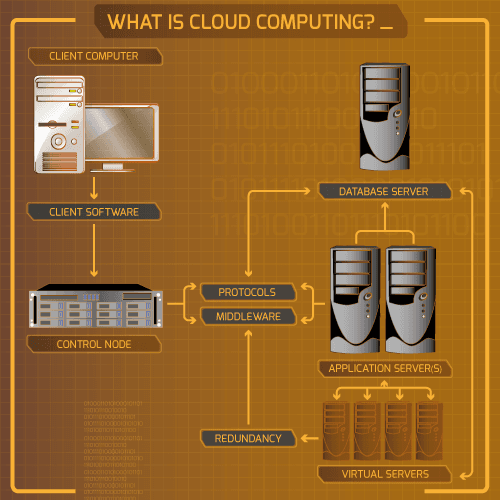These days, it seems that everyone’s doing business exclusively in the cloud. The cloud is economically efficient, stable, scalable and easy to modify. On the other hand, great versatility and popularity also means increased vulnerability. Websites and apps are expected to be available at all times, but cloud servers are prone to query overload issues, where too much traffic crashes your database or compromises quality of service. With a capable load balancing solution in place though, your cloud can serve virtually any volume of queries seamlessly, assuming you have the right setup in place.
Server infrastructure experts are more or less unanimously predicting that on premise servers are on their way to extinction. The advantages of cloud technologies are too great to ignore. Cloud costs are modeled according to use, so there’s no major up-front investment in purchasing infrastructure involved.
When you own your own servers, you’re limited by the capabilities of the hardware, whereas cloud services allow businesses to scale up as they need to; and infrastructure costs are covered primarily by providers. And cloud hosting providers generally guarantee uptime, with SLAs spelling out all the terms and dedicated tech teams maintaining servers on your behalf.
Load balancing technology does come included with some cloud products, but these vary in sophistication and are hardly the standard. It’s worth checking the specs of your cloud service to see if you should be implementing a third-party solution on top of their admin tools.
Don’t Go Down
In the age of instant 24/7 digital gratification, even a few minutes of downtime can have a major impact on your business. In fact, a typical denial-of-service (DDoS) attack can take down your application and last up to 24 hours costing businesses an average of $500,000 per event.
If your site or app is rendered useless, you could find yourself missing out on potential business prospects, losing existing clients, refunding revenue in cases where you violate uptime guarantees to your users, and contending with disgruntled users who might even make a big stink by talking trash about you on social media.
Why Load Balancing & Failover Works
In context of application delivery, load balancing and failover services are typically offered by companies with extensive experience and investment in enterprise level cloud infrastructure.
Traditionally such services relied on a combination of hardware and DNS solutions, acquiring and maintaining which would require a hefty IT budget. However, in the age of SaaS (Software-as-a-Service) providers, load balancing and failover also moved into cloud and are now available for a reasonable cost— one that fits the realities of businesses on a tight budgets.
Offered a subscription based service, such cloud solutions help ensure availability while also eliminating the need to invest in infrastructure and staff that are needed to support the self-managed hardware option.
Today, cloud-based availability services are deliver part of an Application Delivery Controller (ADC) solution which covers the foundations of delivering a reliable cloud-based service: security, acceleration, load distribution and real-time monitoring. This means that applications provide a safe environment for users and run faster regardless of spikes, system errors and unexpected traffic loads.
The failover element ensures that in the event of application errors or if servers become unavailable due to an attack or other emergency, traffic is directed to backup machines that are fresh and ready to begin delivering services - the switchover and recovery is usually unnoticed by the end user. In addition, load balancing ensures that computing load is evenly distributed between multiple servers to ensure that the network performs at maximum speed and with the greatest possible efficiency.
Integrating this solution is somewhat like an insurance policy for the delivery of your business’ products that ensure that whether systems go down due to human error or malicious attacks, the end user will always have access to key resources; eliminating the risk of sales and a damaged reputation.
The good news here is that many of the primary causes of cloud crashes are 100% preventable if you have a good load balancing and failover solution in place. To gain a better understanding of just how much of a game-changer this service is, let’s take a look at three of the most widespread causes of database crashes in the cloud.
- Unpredictable Spikes
Network latency, fluctuation in demand and shifting customer requirements can cause overloading. For instance, marketing channels such as newsletters, social media posts gone viral or in-person events can refer large amounts of traffic to your servers within a short amount of time – that’s the whole point of marketing, isn’t it?
Spikes can come in the form of concurrent connections (too many users sending queries at once) or bandwidth (too many large files – high-resolution images or streaming HD video, for example – being served up at once). Of course, if the site crashes because of overload, your marketing efforts have gone to waste.
- Bot Attacks
Hackers attack databases by sending large numbers of queries which servers mistake as legitimate. In the past year, experts estimate that Botnets, large groups of devices hijacked remotely by hackers to carry out DDoS attacks, have become nearly 2.5 times more common than they were a year ago. With a DDoS attack, the heavy volume of queries crashes your database, causing nothing but error messages to appear for legitimate visitors. Hackers may do this for revenge (disgruntled employees, for example), to hurt their competition or to cloak other criminal activities.
Other bot-based threats can include those masquerading as Google indexing crawlers and scrapers that pull confidential data for identity theft purposes. Better load balancing utilities, bundled with other smart security services, will identify all of these bots as the threats that they are and block them from ever getting through to your database.
- Buggy Code & Human Error
Application bugs are the number one reason for server downtime, trumping even cloud hardware failures. Since the cloud allows for continuous development, testing and deployment of your applications, there is also more room for error.
But even if your own code is bug-free, there’s always the code running via your cloud service provider over which you don’t have the same level of control – bugs can show up in the code of third-party services or code libraries which your system uses as building blocks. Bugs come in all shapes and sizes, but often they can involve algorithmic loops that overload the servers with unnecessary processes.
In cases like these, a failover solution will identify the corrupt process and ensure that an available server with working code and resources are always presented and accessible by your customers.
Failure Can Be Avoided
While cloud computing and services were initially a very vulnerable and risky business, fear of failure is now being quickly eradicated by proven proficient solutions. Make peace with the risks involved with launching a cloud based business and embrace the power and protection provided by robust and affordable load balancing and failover solutions. As more complex services are being delivered in the cloud, you can be confident in business by ensuring that you’ve put in place adequate provisions for the worst-case scenario without a burden on your budget.





